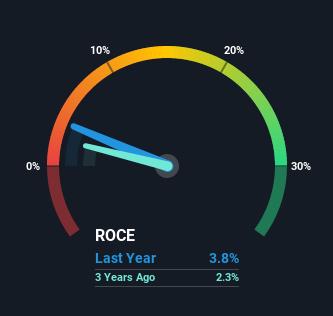The Returns On Capital At Windsor Machines (NSE:WINDMACHIN) Don't Inspire Confidence
If you're looking for a multi-bagger, there's a few things to keep an eye out for. Firstly, we'll want to see a proven return on capital employed (ROCE) that is increasing, and secondly, an expanding base of capital employed. Basically this means that a company has profitable initiatives that it can continue to reinvest in, which is a trait of a compounding machine. Although, when we looked at Windsor Machines (NSE:WINDMACHIN), it didn't seem to tick all of these boxes.
What is Return On Capital Employed (ROCE)?
For those that aren't sure what ROCE is, it measures the amount of pre-tax profits a company can generate from the capital employed in its business. Analysts use this formula to calculate it for Windsor Machines:
Return on Capital Employed = Earnings Before Interest and Tax (EBIT) ÷ (Total Assets - Current Liabilities)
0.038 = ₹143m ÷ (₹5.8b - ₹2.1b) (Based on the trailing twelve months to September 2021).
So, Windsor Machines has an ROCE of 3.8%. In absolute terms, that's a low return and it also under-performs the Machinery industry average of 15%.
See our latest analysis for Windsor Machines

While the past is not representative of the future, it can be helpful to know how a company has performed historically, which is why we have this chart above. If you want to delve into the historical earnings, revenue and cash flow of Windsor Machines, check out these free graphs here.
So How Is Windsor Machines' ROCE Trending?
When we looked at the ROCE trend at Windsor Machines, we didn't gain much confidence. Around five years ago the returns on capital were 5.6%, but since then they've fallen to 3.8%. However, given capital employed and revenue have both increased it appears that the business is currently pursuing growth, at the consequence of short term returns. And if the increased capital generates additional returns, the business, and thus shareholders, will benefit in the long run.
The Key Takeaway
While returns have fallen for Windsor Machines in recent times, we're encouraged to see that sales are growing and that the business is reinvesting in its operations. These growth trends haven't led to growth returns though, since the stock has fallen 25% over the last five years. As a result, we'd recommend researching this stock further to uncover what other fundamentals of the business can show us.
Windsor Machines does have some risks though, and we've spotted 2 warning signs for Windsor Machines that you might be interested in.
While Windsor Machines may not currently earn the highest returns, we've compiled a list of companies that currently earn more than 25% return on equity. Check out this free list here.
Valuation is complex, but we're here to simplify it.
Discover if Windsor Machines might be undervalued or overvalued with our detailed analysis, featuring fair value estimates, potential risks, dividends, insider trades, and its financial condition.
Access Free AnalysisHave feedback on this article? Concerned about the content? Get in touch with us directly. Alternatively, email editorial-team (at) simplywallst.com.
This article by Simply Wall St is general in nature. We provide commentary based on historical data and analyst forecasts only using an unbiased methodology and our articles are not intended to be financial advice. It does not constitute a recommendation to buy or sell any stock, and does not take account of your objectives, or your financial situation. We aim to bring you long-term focused analysis driven by fundamental data. Note that our analysis may not factor in the latest price-sensitive company announcements or qualitative material. Simply Wall St has no position in any stocks mentioned.
About NSEI:WINDMACHIN
Windsor Machines
Engages in the manufacture and sale of plastic processing machinery in India and internationally.
Adequate balance sheet with questionable track record.
Similar Companies
Market Insights
Community Narratives



